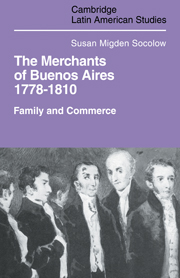Book contents
- Frontmatter
- Contents
- Dedication
- Acknowledgments
- Glossary
- Weights, measures and money
- Introduction
- 1 The merchant population
- 2 Women, marriage and kinship
- 3 Commerce and investment
- 4 Life style
- 5 Religious participation
- 6 Political and social awareness
- 7 Gaspar de Santa Coloma, merchant of Buenos Aires
- Conclusion
- Appendices
- Notes
- Bibliography
- Index
3 - Commerce and investment
Published online by Cambridge University Press: 04 August 2010
- Frontmatter
- Contents
- Dedication
- Acknowledgments
- Glossary
- Weights, measures and money
- Introduction
- 1 The merchant population
- 2 Women, marriage and kinship
- 3 Commerce and investment
- 4 Life style
- 5 Religious participation
- 6 Political and social awareness
- 7 Gaspar de Santa Coloma, merchant of Buenos Aires
- Conclusion
- Appendices
- Notes
- Bibliography
- Index
Summary
The merchants of Buenos Aires were a central force in the economy of the city, its surrounding countryside, and the more distant areas of the Viceroyalty of the Río de la Plata. As traders, moneylenders and investors, the merchants controlled much of the day to day economic life in the colony. In fact, the colonial economy was dominated by commercial capital. The merchants, in their role as local agents of Spanish mercantile policy, sought exports which were in demand in the markets of Cádiz and Madrid. They were also responsible for the movement of goods from one sector of the region to another. The porteño merchants indirectly maintained the entire communication and transportation network of the region.
Several variables determine the status of individual merchants and groups of merchants. The category of trade (i.e., whether it be wholesale or retail) was a major factor in the economic and social status of a merchant. Porteño merchants ranked themselves into three trade categories – wholesalers, retailers, and suppliers of food – based on economic power and social prestige. The wholesalers, the subject of this study, were the most important of the merchant groups, but within this category the scale of trade ranged from large to small. Of a sample group of 90 merchants participating in wholesale trade, 45 were medium-scale merchants, 18 were large-scale merchants, 23 were medium- to large-scale merchants, and only 4 were small-scale importers. Large-scale merchants had invested large sums of money, from 50,000 pesos up, in commerce.
- Type
- Chapter
- Information
- Merchants of Buenos Aires 1778–1810Family and Commerce, pp. 54 - 70Publisher: Cambridge University PressPrint publication year: 1978



